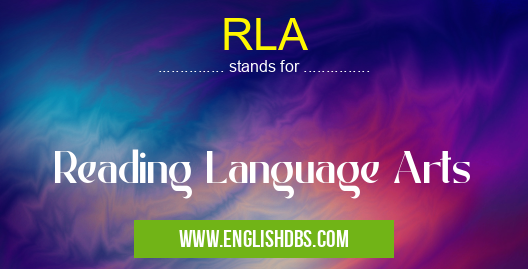What does RLA mean in LANGUAGE & LITERATURE
RLA stands for Reading Language Arts. It's an umbrella term used in education to describe the study of English language skills, including reading, writing, listening, speaking, and viewing. RLA is essential for academic success, as it provides students with the foundation they need to effectively communicate and comprehend information across all academic disciplines.

RLA meaning in Language & Literature in Academic & Science
RLA mostly used in an acronym Language & Literature in Category Academic & Science that means Reading Language Arts
Shorthand: RLA,
Full Form: Reading Language Arts
For more information of "Reading Language Arts", see the section below.
RLA Meaning in SCIENCE
In the context of science education, RLA is critical for students to develop their scientific literacy skills. It enables them to:
- Effectively read and interpret scientific texts, including research articles, textbooks, and lab reports.
- Write clear and concise scientific reports and presentations.
- Listen to and participate in scientific discussions.
- Speak confidently about scientific concepts and findings.
- View and analyze scientific data, diagrams, and videos.
RLA Full Form
The full form of RLA is Reading Language Arts. It consists of the following components:
- Reading: Involves decoding written text and comprehending its meaning.
- Language: Encompasses the study of grammar, vocabulary, and usage.
- Arts: Includes the creative and expressive aspects of language, such as writing and speaking.
Essential Questions and Answers on Reading Language Arts in "SCIENCE»LITERATURE"
What is Reading Language Arts (RLA)?
RLA is an academic field that encompasses reading, writing, speaking, and listening. It aims to develop students' literacy skills through the study of literature, language, and composition.
Why is RLA important?
RLA skills are essential for communication, critical thinking, and lifelong learning. They enable students to effectively express themselves, understand and analyze information, and engage in meaningful discussions.
What are the key elements of RLA instruction?
RLA instruction typically focuses on phonemic awareness, phonics, vocabulary, reading comprehension, writing mechanics, grammar, and literary analysis. Teachers use a variety of methods, including reading aloud, guided reading, writing workshops, and discussion-based activities.
How can parents support their children's RLA development?
Parents can support their children's RLA development by reading to them regularly, encouraging them to write and draw, and engaging in meaningful conversations. Additionally, they can provide access to books and other literacy materials.
What are some common challenges in RLA instruction?
Some challenges in RLA instruction include:
- Students with different learning styles and needs
- Lack of access to resources or support
- Limited opportunities for reading and writing
- Disengagement from reading and language-based activities
What can teachers do to address challenges in RLA instruction?
To address challenges in RLA instruction, teachers can:
- Differentiate instruction to meet the needs of all learners
- Provide additional support and resources to struggling students
- Create a positive and engaging learning environment
- Foster a love of reading and writing
Final Words: RLA is a fundamental component of education, providing students with the skills they need to succeed in academic and professional settings. By fostering literacy skills, RLA empowers individuals to communicate effectively, access information, and actively participate in society.
RLA also stands for: |
|
| All stands for RLA |
